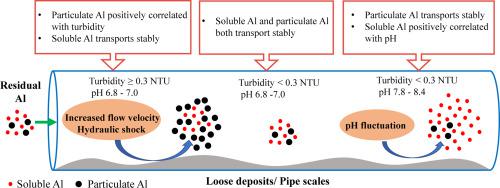Chemosphere ( IF 8.8 ) Pub Date : 2021-02-22 , DOI: 10.1016/j.chemosphere.2021.130067 Yitian He , Linlin Pan , Ruya Chen , Baoyou Shi

|
Aluminum (Al) release and deposition in drinking water distribution systems (DWDS) are highly detrimental to tap water quality. In this study, five drinking water treatment plant supply areas in two cities of China were examined to understand the transportation stability of Al in the DWDS. The two cities were selected based on the wide disparity reported in pH and turbidity in the finished and tap water qualities, with higher fluctuation of pH (average 8.0) and turbidity (average 0.78 NTU) reported in the northern and southern cities, respectively. Results showed that hydraulic conditions such as hydraulic shock or increased flow velocity had a more significant effect on the release and deposition of particulate Al, which could be reflected by turbidity when it was greater than 0.3 NTU, since turbidity and particulate Al were significantly positively correlated. Particulate Al concentration varied by more than 140 μg/L when turbidity fluctuated within 0.45–1.67 NTU. However, when turbidity was below 0.3 NTU, the particulate Al transported stably at low concentration. pH fluctuations contributed to the change of soluble Al concentration. Even above 50 μg/L soluble Al in the finished water could transport stably in the DWDS when pH fluctuated slightly in 6.6–7.0. However, when the pH fluctuated in 7.8–8.4, the soluble Al concentration varied by more than 100 μg/L. This study provides reference indicators of turbidity and pH for identifying the risk of Al in the DWDS.



























 京公网安备 11010802027423号
京公网安备 11010802027423号